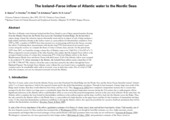The Iceland–Faroe inflow of Atlantic water to the Nordic Seas
Peer reviewed, Journal article
Permanent lenke
https://hdl.handle.net/1956/378Utgivelsesdato
2003-12Metadata
Vis full innførselSamlinger
- Geophysical Institute [1228]
Originalversjon
https://doi.org/10.1016/j.pocean.2003.10.003Sammendrag
The flow of Atlantic water between Iceland and the Faroe Islands is one of three current branches flowing from the Atlantic Ocean into the Nordic Seas across the Greenland–Scotland Ridge. By the heat that it carries along, it keeps the subarctic regions abnormally warm and by its import of salt, it helps maintain a high salinity and hence density in the surface waters as a precondition for thermohaline ventilation. From 1997 to 2001, a number of ADCPs have been moored on a section going north from the Faroes, crossing the inflow. Combining these measurements with decade-long CTD observations from research vessel cruises along this section, we compute the fluxes of water (volume), heat, and salt. For the period June 1997–June 2001, we found the average volume flux of Atlantic water to be 3.5 ± 0.5 Sv (1 Sv = 106 m3·s1). When compared to recent estimates of the other branches, this implies that the Iceland– Faroe inflow is the strongest branch in terms of volume flux, transporting 47% of the total Atlantic inflow to the Arctic Mediterranean (Nordic Seas and Arctic Ocean with shelf areas). If all of the Atlantic inflow were assumed to be cooled to 0 °C, before returning to the Atlantic, the Iceland–Faroe inflow carries a heat flux of 124 ± 15 TW (1 TW = 1012 W), which is about the same as the heat carried by the inflow through the Faroe–Shetland Channel. The Iceland–Faroe Atlantic water volume flux was found to have a negligible seasonal variation and to be remarkably stable with no reversals, even on daily time scales. Out of a total of 1348 daily flux estimates, not one was directed westwards towards the Atlantic.
